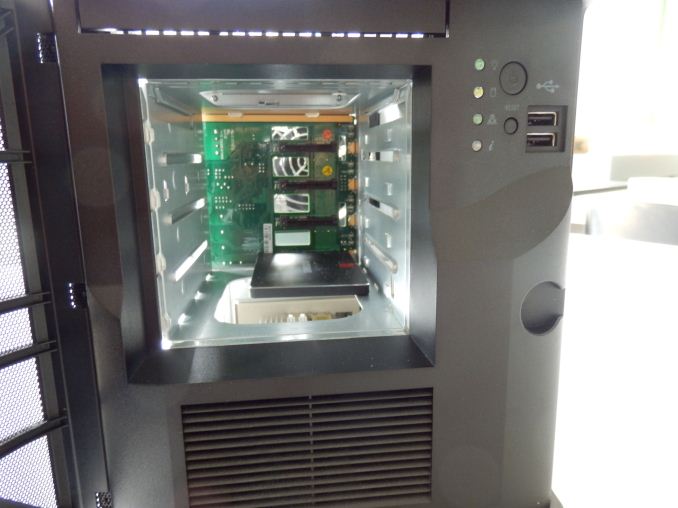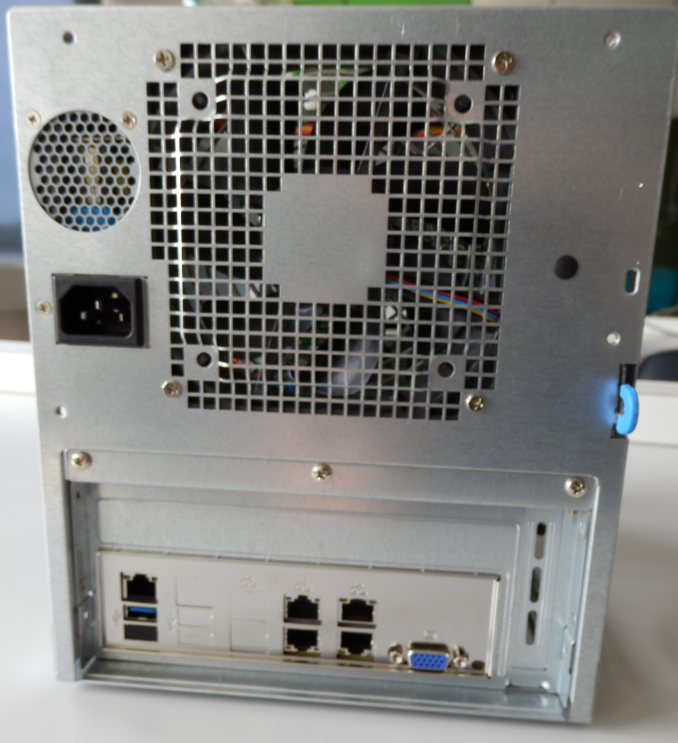The Intel Xeon D Review: Performance Per Watt Server SoC Champion?
by Johan De Gelas on June 23, 2015 8:35 AM EST- Posted in
- CPUs
- Intel
- Xeon-D
- Broadwell-DE
Supermicro's SuperServer 5028D-TN4T
Supermicro has always been one of the first server vendors that integrates new Intel technology. The Supermicro SYS-5028D-TN4T is a mini-tower, clearly targeted at Small Businesses that still want to keep their server close instead of in the cloud, which is still a strategy that makes sense in quite a few situations.
The system features four 3.5 inch hot swappable drive bays, which makes it easy to service the component that fails the most in a server system: the magnetic disks.
That being said, we feel that the system falls a bit short with regards to serviceability. For example replacing DIMMs or adding an SSD (in one of fixed 2.5 inch bays) requires you to remove some screws and to apply quite a bit of force to remove the cover of the chassis.
Tinkering with DIMMs under the storage bays is also a somewhat time consuming experience. You can slide out the motherboard, but that requires to remove almost all cabling. Granted, most system administrators will rarely replace SSDs or DIMMs. But the second most failing component is the PSU, which is not easy swappable either but attached with screws to chassis.
On the positive side, an AST2400 BMC is present and allows you to administer the system remotely via a dedicated Ethernet interface. Supermicro also added an Intel i350 dual gigabit LAN controller. So you have ample networking resources: one remote control ethernet port, two gigabit and two 10 gigabit (10GBase-T) ports, courtesy of the Xeon-D integrated 10 GbE Ethernet MAC.













90 Comments
View All Comments
JohanAnandtech - Wednesday, June 24, 2015 - link
Hi Patrick, the base clock of our chip is 2 GHz, not 1.9 GHz as the one pre-production version that we got from Intel. I have to check the turboclocks though, but I do believe we have measured 2.6 GHz. I'll doublecheck.pjkenned - Wednesday, June 24, 2015 - link
Awesome! Our ES ones were 1.9GHz.Chrisrodinis1 - Tuesday, June 23, 2015 - link
For comparison, this server uses Xeon's. It is the HP Proliant BL460c G9 blade server: https://www.youtube.com/watch?v=0s_w8JVmvf0MrDiSante - Wednesday, June 24, 2015 - link
Why use only -O2 when compiling the benchmarks? I would imagine that in order to squeeze out every last bit of performance, all production software is compiled with all optimizations turned up to 11. I noticed that their github uses -O2 as an example - is it that TinyMemBenchmark just doesn't play nice with -O3?JohanAnandtech - Wednesday, June 24, 2015 - link
The standard makefile had no optimization whatsoever. If you want to measure latency, you do not want maximum performance but rather accuracy, so I played it safe and used -O2. I am not convinced that all production software is optimized with all optimization turned on.diediealldie - Wednesday, June 24, 2015 - link
Intel seems disARMing them... X-Gene 2 doesn't look so promising, as they'll have to fight mighty Skylake-based Xeons, not Broadwell ones.Thanks for great article again.
jfallen - Wednesday, June 24, 2015 - link
Thanks Johan for the great article. I'm a tech enthusiast, and will never buy or use one of these. But it makes great reading and I appreciate the time you take to research and write the article.Regards
Jordan
JohanAnandtech - Wednesday, June 24, 2015 - link
Happy to read this! :-)TomWomack - Wednesday, June 24, 2015 - link
This looks very much consistent with my experience; the disconcertingly high idle power (I looked at the board with a thermal camera; the hot chips were the gigabit PHY, the inductors for the power supply, and the AST2400 management chip), the surprisingly good memory performance, the fairly hot SoC (running sixteen threads of number-crunching I get a power draw of 83W at the plug) and the generally pretty good computation.I'm not entirely sure it was a better buy for my use case than a significantly cheaper 6-core Haswell E - Haswell E is not that hot, electricity not that expensive, and from my supplier the X10SDV-F board and memory were £929 whilst Scan get me an i7-5820K board, CPU and memory for £702. And four-channel DDR4 probably is usefully faster than two-channel for what I do.
I quite strongly don't believe in server mystique - the outbuilding is big enough that I run out of power before I run out of space for micro-ATX cases, and I am lucky enough to be doing calculations which are self-checking to the point that ECC is a waste of money.
JohanAnandtech - Wednesday, June 24, 2015 - link
Hi Tom, I believe we saw up to 90 Watt at the wall when running OpenFOAM (10 Gbit enabled). It is however less relevant for such a chip which is not meant to be a HPC chip as we have shown in the article. HPC really screams for an E5.